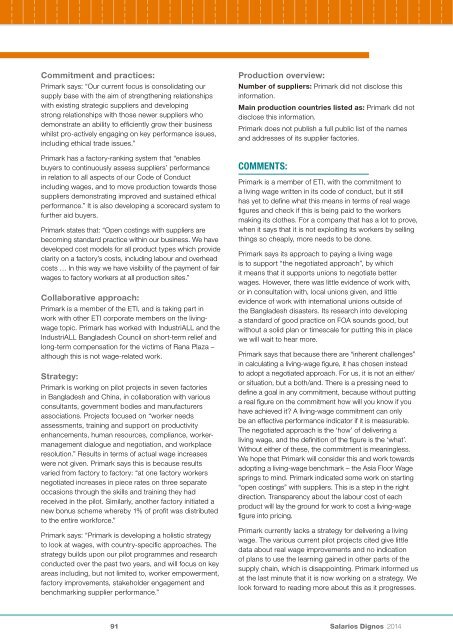17Investigación SALARIOS dignos definitiva
17Investigación SALARIOS dignos definitiva
17Investigación SALARIOS dignos definitiva
You also want an ePaper? Increase the reach of your titles
YUMPU automatically turns print PDFs into web optimized ePapers that Google loves.
Commitment and practices:<br />
Primark says: “Our current focus is consolidating our<br />
supply base with the aim of strengthening relationships<br />
with existing strategic suppliers and developing<br />
strong relationships with those newer suppliers who<br />
demonstrate an ability to efficiently grow their business<br />
whilst pro-actively engaging on key performance issues,<br />
including ethical trade issues.”<br />
Primark has a factory-ranking system that “enables<br />
buyers to continuously assess suppliers’ performance<br />
in relation to all aspects of our Code of Conduct<br />
including wages, and to move production towards those<br />
suppliers demonstrating improved and sustained ethical<br />
performance.” It is also developing a scorecard system to<br />
further aid buyers.<br />
Primark states that: “Open costings with suppliers are<br />
becoming standard practice within our business. We have<br />
developed cost models for all product types which provide<br />
clarity on a factory’s costs, including labour and overhead<br />
costs … In this way we have visibility of the payment of fair<br />
wages to factory workers at all production sites.”<br />
Collaborative approach:<br />
Primark is a member of the ETI, and is taking part in<br />
work with other ETI corporate members on the livingwage<br />
topic. Primark has worked with IndustriALL and the<br />
IndustriALL Bangladesh Council on short-term relief and<br />
long-term compensation for the victims of Rana Plaza –<br />
although this is not wage-related work.<br />
Strategy:<br />
Primark is working on pilot projects in seven factories<br />
in Bangladesh and China, in collaboration with various<br />
consultants, government bodies and manufacturers<br />
associations. Projects focused on “worker needs<br />
assessments, training and support on productivity<br />
enhancements, human resources, compliance, workermanagement<br />
dialogue and negotiation, and workplace<br />
resolution.” Results in terms of actual wage increases<br />
were not given. Primark says this is because results<br />
varied from factory to factory: “at one factory workers<br />
negotiated increases in piece rates on three separate<br />
occasions through the skills and training they had<br />
received in the pilot. Similarly, another factory initiated a<br />
new bonus scheme whereby 1% of profit was distributed<br />
to the entire workforce.”<br />
Primark says: “Primark is developing a holistic strategy<br />
to look at wages, with country-specific approaches. The<br />
strategy builds upon our pilot programmes and research<br />
conducted over the past two years, and will focus on key<br />
areas including, but not limited to, worker empowerment,<br />
factory improvements, stakeholder engagement and<br />
benchmarking supplier performance.”<br />
Production overview:<br />
Number of suppliers: Primark did not disclose this<br />
information.<br />
Main production countries listed as: Primark did not<br />
disclose this information.<br />
Primark does not publish a full public list of the names<br />
and addresses of its supplier factories.<br />
COMMENTS:<br />
Primark is a member of ETI, with the commitment to<br />
a living wage written in its code of conduct, but it still<br />
has yet to define what this means in terms of real wage<br />
figures and check if this is being paid to the workers<br />
making its clothes. For a company that has a lot to prove,<br />
when it says that it is not exploiting its workers by selling<br />
things so cheaply, more needs to be done.<br />
Primark says its approach to paying a living wage<br />
is to support “the negotiated approach”, by which<br />
it means that it supports unions to negotiate better<br />
wages. However, there was little evidence of work with,<br />
or in consultation with, local unions given, and little<br />
evidence of work with international unions outside of<br />
the Bangladesh disasters. Its research into developing<br />
a standard of good practice on FOA sounds good, but<br />
without a solid plan or timescale for putting this in place<br />
we will wait to hear more.<br />
Primark says that because there are “inherent challenges”<br />
in calculating a living-wage figure, it has chosen instead<br />
to adopt a negotiated approach. For us, it is not an either/<br />
or situation, but a both/and. There is a pressing need to<br />
define a goal in any commitment, because without putting<br />
a real figure on the commitment how will you know if you<br />
have achieved it A living-wage commitment can only<br />
be an effective performance indicator if it is measurable.<br />
The negotiated approach is the ‘how’ of delivering a<br />
living wage, and the definition of the figure is the ‘what’.<br />
Without either of these, the commitment is meaningless.<br />
We hope that Primark will consider this and work towards<br />
adopting a living-wage benchmark – the Asia Floor Wage<br />
springs to mind. Primark indicated some work on starting<br />
“open costings” with suppliers. This is a step in the right<br />
direction. Transparency about the labour cost of each<br />
product will lay the ground for work to cost a living-wage<br />
figure into pricing.<br />
Primark currently lacks a strategy for delivering a living<br />
wage. The various current pilot projects cited give little<br />
data about real wage improvements and no indication<br />
of plans to use the learning gained in other parts of the<br />
supply chain, which is disappointing. Primark informed us<br />
at the last minute that it is now working on a strategy. We<br />
look forward to reading more about this as it progresses.<br />
91<br />
Salarios Dignos 2014


